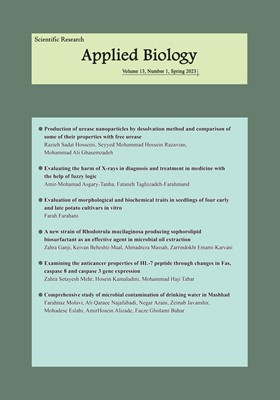Comprehensive study of microbial contamination of drinking water in Mashhad
Subject Areas : microbiologyFarahnaz Molavi 1 , Ali Qaraee Najafabadi 2 , Negar Azani 3 , Zeinab Javanshir 4 , Mohadese Eslahi 5 , AmirHosein Alizade 6 , Faeze Gholami Bahar 7
1 - Assistant Professor, Department of Biology, Mashhad Branch, Islamic Azad University, Mashhad, Iran
2 - Bachelor Student, Department of Biology, Mashhad Branch, Islamic Azad University, Mashhad, Iran
3 - Bachelor Student, Department of Biology, Mashhad Branch, Islamic Azad University, Mashhad, Iran
4 - Bachelor Student, Department of Biology, Mashhad Branch, Islamic Azad University, Mashhad, Iran.
5 - Bachelor Student, Department of Biology, Mashhad Branch, Islamic Azad University, Mashhad, Iran
6 - Bachelor Student, Department of Biology, Mashhad Branch, Islamic Azad University, Mashhad, Iran
7 - Bachelor Student, Department of Biology, Mashhad Branch, Islamic Azad University, Mashhad, Iran.
Keywords: total coliform, Mashhad City, Bacteria, Fungi, drinking water, Fecal coliform,
Abstract :
Objective: Mashhad is the most important city in the country due to its tourist and pilgrimage attractions, and ensuring the safety of its drinking water is very important, especially for travelers. The aim of the present study was to investigate the microbial quality of drinking water in MashhadMaterials and methods: This is a field research and a cross-sectional study. Sampling locations were determined by systematic sampling method. The drinking water of 15 selected stations was studied during 10 months from February 2019 to the end of December 2011. Each station was sampled 4 times in 4 different seasons. The samples were studied in three parts of bacterial, fungal and protozoan contamination assessment, according to existing standards.Findings: The microbial quality of Mashhad's drinking water supply sources was very favorable in terms of total and faecal coliform contamination and was in line with the national standard. From a total of 220 fungal colonies grown, 7 different genera of fungi were identified. In general, the average CFU of isolated fungi for samplesper 100 ml of water was 6.2.The most common isolated fungus was Aspergillus (40.45%) and the least isolated colony was related to Fusarium (1.3%). No samples of protozoans or cysts related to protozoans were observed in any station.Conclusion: According to the guidelines of the World Health Organization in 2006 for evaluating the microbial health of water, the drinking water quality of Mashhad was in accordance with the national standard. Mashhad's drinking water also contains various fungi. Therefore, it is suggested that in the regular monitoring of the urban water system in terms of microbial contamination, fungi should also be investigated as one of the important microorganisms. Regarding contamination with protozoa, no contamination was observed. In order to maintain the desirability of drinking water in Mashhad city, it is suggested that the water and sewage company continuously monitor the quality of drinking water sources.


